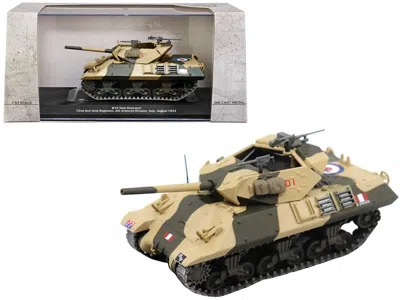Brand new 1/43 scale diecast model of M10 Tank Destroyer D1 #77 "U.S.A. 72nd Anti-Tank Regiment, 6th Armored Division, Italy, August 1944" die cast model by AFVs of WWII. Brand new box. Detailed exterior. True-to-scale detail. Officially licensed product. Comes in plastic display showcase. This model does not have any openings. Manufacturer's original unopened packaging. Made of diecast metal with some plastic parts. Dimensions approximately L-6, W-2.25, H-2.75 inches. The M10 tank destroyer, formally 3-inch Motor Carriage, M10 was a United States tank destroyer of World II based on the chassis of the M4 Sherman tank. It was numerically the most important U.S. tank destroyer of World II and combined a reasonably potent anti-tank with a turreted platform (unlike the previous M3 GMC, whose was capable of only limited traverse). Despite the introduction of more-powerful types as replacements, it remained in service until the end of the.

AFV'S OF WWII M10 Tank Destroyer D1 #77 "u. S.a. 72nd Anti-tank Regiment 6th Armored Division Italy August 1944" 1 In Green
Compare Across 800+ Stores



M10 Tank Destroyer D1 #77 "u. S.a. 72nd Anti-tank Regiment 6th Armored Division Italy August 1944" 1 In Green
Brand new 1/43 scale diecast model of M10 Tank Destroyer D1 #77 "U.S.A. 72nd Anti-Tank Regiment, 6th Armored Division, Italy, August 1944" die cast model by AFVs of WWII. Brand new box. Detailed exterior. True-to-scale detail. Officially licensed product. Comes in plastic display showcase. This model does not have any openings. Manufacturer's original unopened packaging. Made of diecast metal with some plastic parts. Dimensions approximately L-6, W-2.25, H-2.75 inches. The M10 tank destroyer, formally 3-inch Motor Carriage, M10 was a United States tank destroyer of World II based on the chassis of the M4 Sherman tank. It was numerically the most important U.S. tank destroyer of World II and combined a reasonably potent anti-tank with a turreted platform (unlike the previous M3 GMC, whose was capable of only limited traverse). Despite the introduction of more-powerful types as replacements, it remained in service until the end of the.